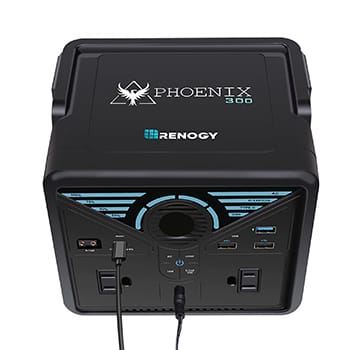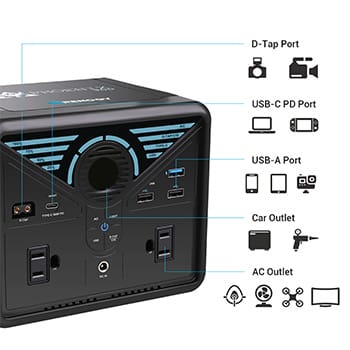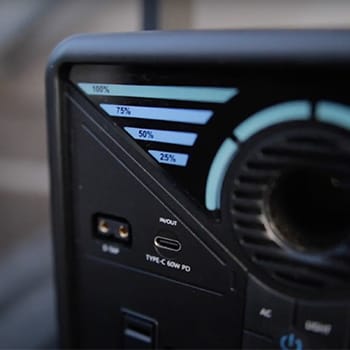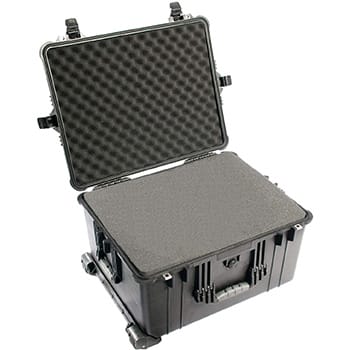When I go camping in the great outdoors, I like to have a solar power system with me so that I can always harness some power from the good ol’ sun when I need it.
However, I don’t want to lug around a huge, heavy portable power station that weighs a ton, so I’ve been looking into micro solar generators lately.
This led me to the Renogy Phoenix 300 solar generator.
At just 6.4 lbs, it’s one of the smallest solar generators in its class, but does it fulfill my power needs?
What Is The Renogy Phoenix 300?

The Renogy Phoenix generator is a “micro solar generator” that stores 337 watt-hours of charge in its battery, providing plenty of power for small and medium digital devices like laptops, smartphones, tablets, and cameras.
Unlike gas generators, solar generators like the Renogy Phoenix 300 can be used indoors or outdoors, so they’re perfect for using in your tent at night and leaving to charge in the sun during the day.
There are multiple options for charging the Phoenix, including AC wall outlet charging, DC car power charging, and solar panels.
Outputs on this device include:
- 2 x AC 110v wall outlets
- Quick charging USB-A port
- 2 x USB-A ports
- 1 x USB-C port
- 1 x CIG port
- D-Tap battery port
You can also expect features such as overcurrent protection, short circuit protection, LED flashlights (for emergencies), voltage control, a pure sine wave inverter, and a smart battery management system (BMS).
What’s Included In The Box For The Renogy Phoenix 300?
In the box for the Renogy Phoenix, you will find:
- The Renogy Phoenix portable solar generator
- USB-A to USB-C cable
- AC/DC adapter
- 5.5mm DC adapter
How Long Does A Full Charge Of The Renogy Phoenix 300 Last?
Depending on how you use the Phoenix power station, the charge will last for different amounts of time.
Powering LED lights could see the battery pack last for days, while powering larger electronics like laptops could drain the battery in about 6 hours.
How Long Does It Take To Charge The Renogy Phoenix 300?
Even using standard power supplies, the Phoenix takes a long time to charge. Charging from an AC power outlet, you’re looking at 8 hours.
When it comes to solar panels, it could be 10-20 hours to charge this unit.

What Can The Renogy Phoenix 300 Power?
The Phoenix generator could power:
- DSLR camera battery – 30 times
- Laptop – 3-4 times
- Drone – 12 times
- Smartphone – 18 times
Obviously, this can vary depending on the specific devices and appliances you’re using.

Renogy Phoenix 300 Benefits
Eco-friendly Charging Options

You have multiple ways to charge this power station, including solar panels.
I personally use my monocrystalline solar panels to charge this unit whenever I can so that I reduce my dependence on grid power.
However, as is often the case with these products, it can take a LONG time to charge with a solar panel.
Lightweight
At only 6.4 lbs, this is one of the lightest products in this price range.
Just be careful not to drop it.
Decent Battery Capacity
The Phoenix has a decent battery capacity and output for a unit of such a small size.
Renogy Phoenix 300 Shortfalls
Personally, this is one portable back up system that I’m not a huge fan of. Here are some of the downsides you need to keep in mind with this generator:
It Takes A Long Time To Charge From A Wall Outlet
If you’re using a wall AC outlet to charge this unit, which is the quickest way to charge it, then expect to wait at least 8 hours for a full charge.
You are able to charge this through both AC power and DC power simultaneously, but even then it will take 3.5 hours to charge fully.

It Takes Even Longer To Charge With A Solar Panel
If you’re looking to be eco-friendly and charge this with solar panels, you’ll be looking at anywhere from 10-20 hours if you’ve got good conditions.
If you’re somewhere with overcast conditions and low levels of sunlight, it could be 20+ hours before this unit charges.
Yikes.
The Battery Indicator Is Limited
Though the unit comes with an indicator for the charge of the lithium-ion battery, it’s split up into 25% chunks, which is not great.
In other words, if you’re milking the last dregs of power outta this unit, you’ll have no idea when it’s about to die once you dip below 25% power.

You Can’t Use The Input And Output Simultaneously
You cannot charge your devices with the Phoenix while simultaneously charging up the battery pack on this unit itself.
If you try to charge this power station with a DC input port (for example) and then plug in your smartphone through the USB port, the battery of the Phoenix will stop charging.
This isn’t the end of the world, but it’s inconvenient for sure. Especially if you’re using solar power.
Pros and Cons Summary of the Renogy Phoenix 300
Pros
Cons
- Lightweight (6.4 lbs)
- Decent material and output ports
- Small size
- Solar panel compatible
- 8+ hours to charge (110v 60hz wall AC frequency)
- 10-20+ hours (or more) solar charging
- Lithium-ion battery could be bigger
- Battery indicator only in 25% chunks
- Can’t use input and output simultaneously
- Limited applications
Things To Consider Before Buying A Portable Solar Generator
What Are Your Power Demands?
You might think that you need high energy lithium-ion battery cells with huge capacities, but if you’re just going on camping adventures for a couple of days, a small portable solar generator like the Phoenix or the Jackery 500 is usually enough.
Don’t buy a bigger power station than you need — it’ll just weigh you down.
Do You Need Any Extra Features?
Think about the scenarios you’ll be using your unit in and what features could help you.
For instance, built-in LED lights are great for blackouts, temperature control is good for hot climates, carry handles are great for camping, and D-tap battery outputs are brilliant for YouTubers and photographers who need to charge digital camera batteries on the go.
Be prepared, as the scouts say.
What’s Your Climate Like?
If you’re planning to charge the item with solar panels, consider the conditions and the climate of where you are.
Not everywhere is LA.
Smaller power stations like the Renogy can only accept 50W solar charging, which means 10-20 hours of solar charging in GOOD conditions.
If you live somewhere that’s overcast, you can easily be waiting days and days for a full charge from solar power alone.
What Can You Afford?
In an ideal world, we’d select the generator with the best capability and overall package of features that suit our needs.
However, price is an important aspect for most of us. Make sure you can afford the price of whatever portable solar generator you’re looking for.
The Renogy Phoenix 300: Should You Buy It?

While there are some upsides to this review, I would say that the Phoenix 300 generator is a very limited package with limited applications due to its small size and long charging times.
For campers, adventurers, and those who want basic backup power, I’d recommend getting the Jackery Explorer 500 instead.
The Jackery 500 has 500 wH of charge (an approximately 50% increase), as well as the capability for 100W solar charging, meaning it can charge twice as quickly as the Phoenix through solar panels.
The Explorer 500 even has an LCD screen that displays the exact percentage of the battery life, so you know exactly how much life is left until things go dark. If you need more power in general, you could also try the Jackery Explorer 1000 too.
I hope you enjoyed this review. Though the Phoenix has its pluses, I would thoroughly recommend the Jackery Explorer 500 to anyone considering buying the Phoenix 300.

